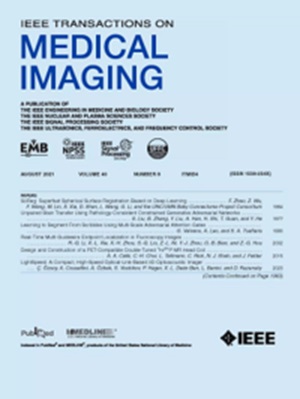Multi-modal learning for predicting the genotype of glioma
IF 8.9
1区 医学
Q1 COMPUTER SCIENCE, INTERDISCIPLINARY APPLICATIONS
引用次数: 4
Abstract
The isocitrate dehydrogenase (IDH) gene mutation is an essential biomarker for the diagnosis and prognosis of glioma. It is promising to better predict glioma genotype by integrating focal tumor image and geometric features with brain network features derived from MRI. Convolutional neural networks show reasonable performance in predicting IDH mutation, which, however, cannot learn from non-Euclidean data, e.g., geometric and network data. In this study, we propose a multi-modal learning framework using three separate encoders to extract features of focal tumor image, tumor geometrics and global brain networks. To mitigate the limited availability of diffusion MRI, we develop a self-supervised approach to generate brain networks from anatomical multi-sequence MRI. Moreover, to extract tumor-related features from the brain network, we design a hierarchical attention module for the brain network encoder. Further, we design a bi-level multi-modal contrastive loss to align the multi-modal features and tackle the domain gap at the focal tumor and global brain. Finally, we propose a weighted population graph to integrate the multi-modal features for genotype prediction. Experimental results on the testing set show that the proposed model outperforms the baseline deep learning models. The ablation experiments validate the performance of different components of the framework. The visualized interpretation corresponds to clinical knowledge with further validation. In conclusion, the proposed learning framework provides a novel approach for predicting the genotype of glioma.预测神经胶质瘤基因型的多模式学习
异柠檬酸脱氢酶(IDH)基因突变是神经胶质瘤诊断和预后的重要生物标志物。通过将局灶性肿瘤图像和几何特征与MRI衍生的脑网络特征相结合,可以更好地预测神经胶质瘤基因型。卷积神经网络在预测IDH突变方面表现出合理的性能,然而,它不能从非欧几里得数据中学习,例如几何和网络数据。在这项研究中,我们提出了一个多模式学习框架,使用三个独立的编码器来提取局灶性肿瘤图像、肿瘤几何和全局脑网络的特征。为了缓解扩散MRI的有限可用性,我们开发了一种自监督方法,从解剖多序列MRI生成大脑网络。此外,为了从脑网络中提取肿瘤相关特征,我们为脑网络编码器设计了一个分层注意力模块。此外,我们设计了一个双水平的多模态对比损失,以对齐多模态特征,并解决局灶性肿瘤和全脑的域间隙。最后,我们提出了一个加权总体图来整合多模态特征,用于基因型预测。在测试集上的实验结果表明,所提出的模型优于基线深度学习模型。烧蚀实验验证了框架不同组件的性能。可视化的解释对应于具有进一步验证的临床知识。总之,所提出的学习框架为预测神经胶质瘤的基因型提供了一种新的方法。
本文章由计算机程序翻译,如有差异,请以英文原文为准。
求助全文
约1分钟内获得全文
求助全文
来源期刊

IEEE Transactions on Medical Imaging
医学-成像科学与照相技术
CiteScore
21.80
自引率
5.70%
发文量
637
审稿时长
5.6 months
期刊介绍:
The IEEE Transactions on Medical Imaging (T-MI) is a journal that welcomes the submission of manuscripts focusing on various aspects of medical imaging. The journal encourages the exploration of body structure, morphology, and function through different imaging techniques, including ultrasound, X-rays, magnetic resonance, radionuclides, microwaves, and optical methods. It also promotes contributions related to cell and molecular imaging, as well as all forms of microscopy.
T-MI publishes original research papers that cover a wide range of topics, including but not limited to novel acquisition techniques, medical image processing and analysis, visualization and performance, pattern recognition, machine learning, and other related methods. The journal particularly encourages highly technical studies that offer new perspectives. By emphasizing the unification of medicine, biology, and imaging, T-MI seeks to bridge the gap between instrumentation, hardware, software, mathematics, physics, biology, and medicine by introducing new analysis methods.
While the journal welcomes strong application papers that describe novel methods, it directs papers that focus solely on important applications using medically adopted or well-established methods without significant innovation in methodology to other journals. T-MI is indexed in Pubmed® and Medline®, which are products of the United States National Library of Medicine.
 求助内容:
求助内容: 应助结果提醒方式:
应助结果提醒方式:


